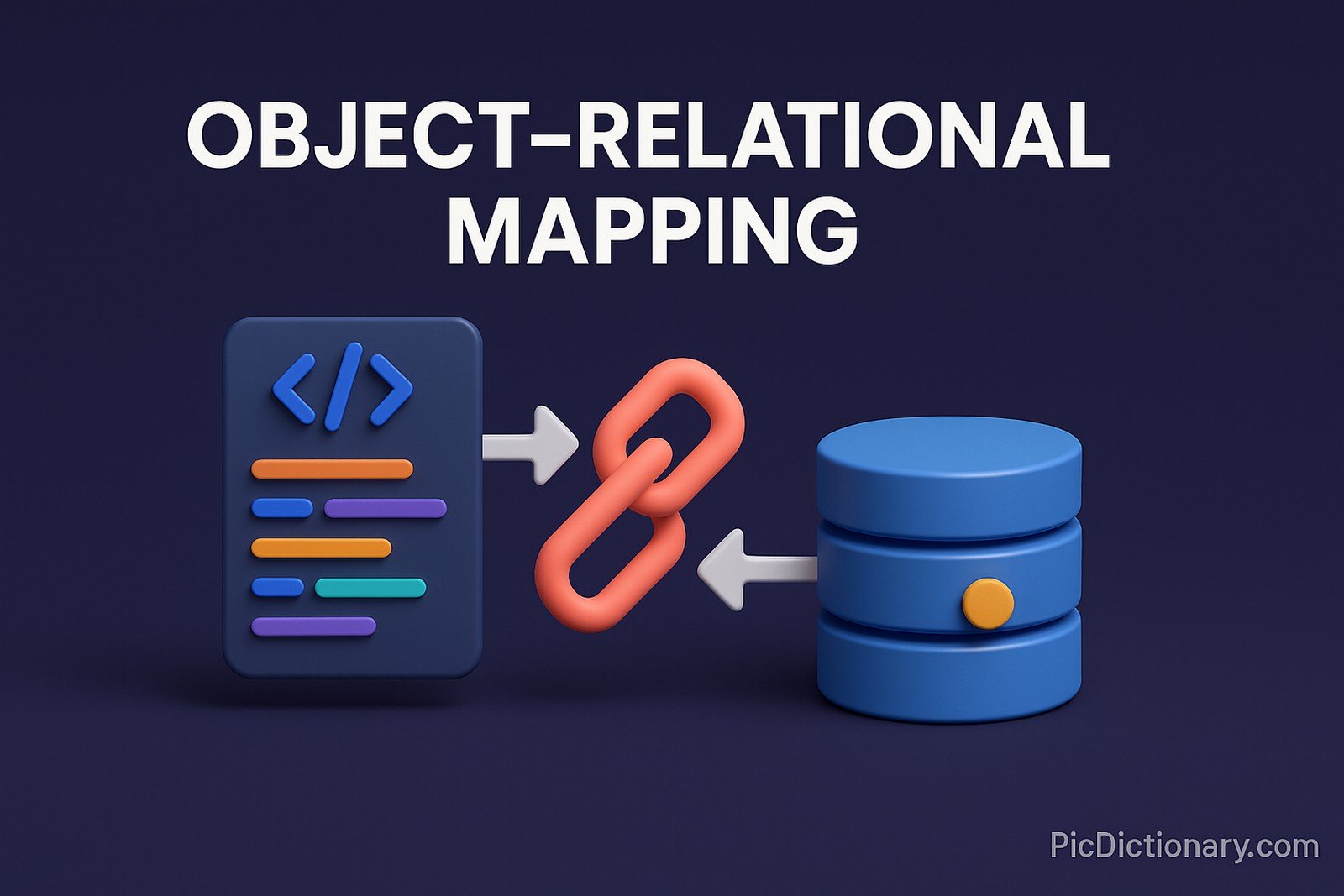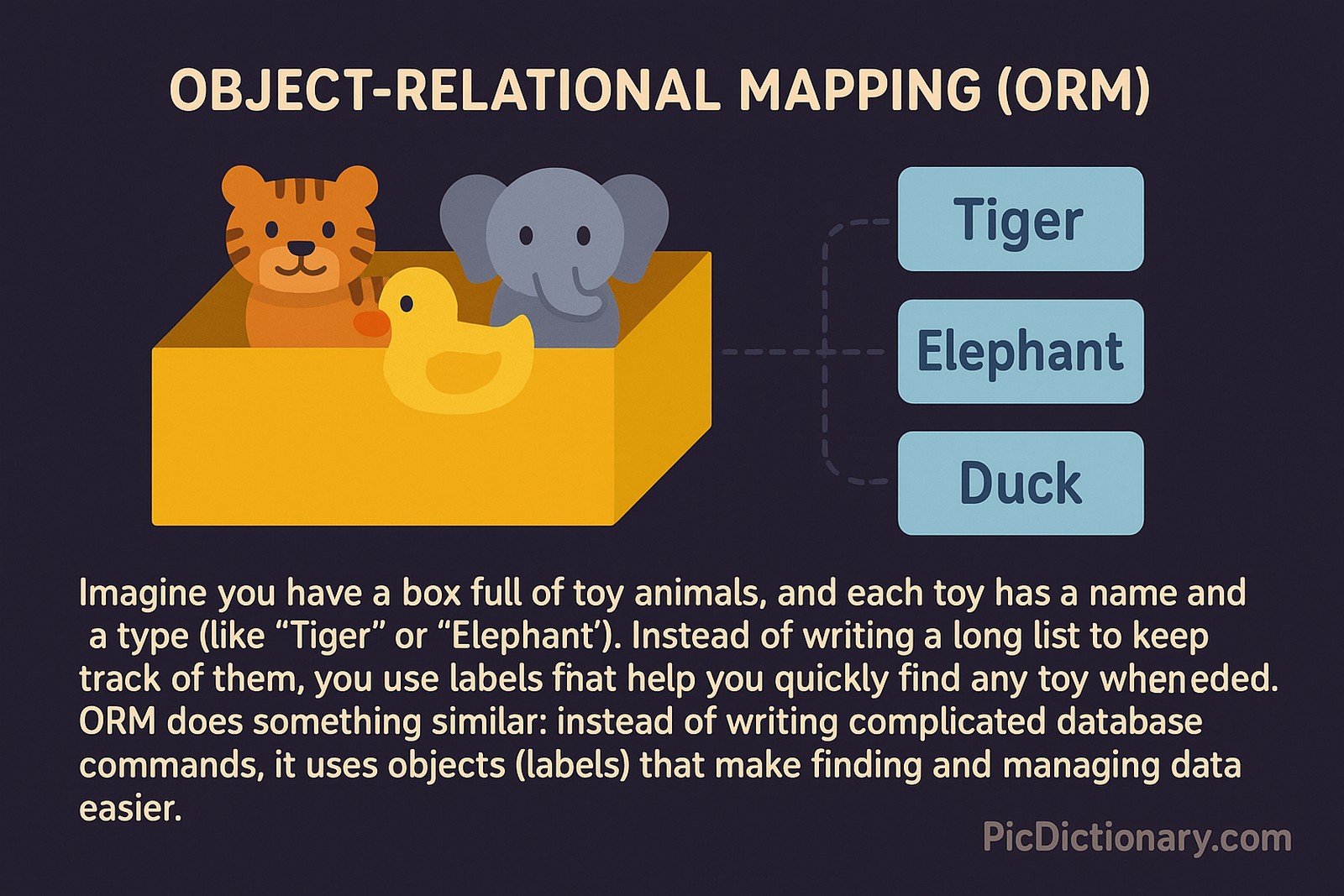Object-Relational Mapping (ORM)

Quick Navigation:
- ORM Definition
- ORM Explained Easy
- ORM Origin
- ORM Etymology
- ORM Usage Trends
- ORM Usage
- ORM Examples in Context
- ORM FAQ
- ORM Related Words
ORM Definition
Object-Relational Mapping (ORM) is a programming technique that enables developers to interact with a relational database using object-oriented programming paradigms. Instead of writing SQL queries manually, ORM frameworks map database tables to objects in a programming language, simplifying database operations. Popular ORM frameworks include Hibernate (Java), Entity Framework (.NET), and SQLAlchemy (Python). ORM automates database interaction, reducing redundancy, improving maintainability, and promoting database independence.
ORM Explained Easy
Imagine you have a box full of toy animals, and each toy has a name and a type (like “Tiger” or “Elephant”). Instead of writing a long list to keep track of them, you use labels that help you quickly find any toy when needed. ORM does something similar: instead of writing complicated database commands, it uses objects (labels) that make finding and managing data easier.
ORM Origin
The concept of ORM emerged in the late 1990s as developers sought ways to bridge the gap between object-oriented programming and relational databases. The growing complexity of software projects highlighted the need for efficient database interactions without excessive SQL coding.
ORM Etymology
The term “Object-Relational Mapping” combines “Object” (from object-oriented programming), “Relational” (from relational databases), and “Mapping” (denoting the connection between the two).
ORM Usage Trends
ORM has become a standard in modern software development, especially with the rise of web applications, microservices, and cloud-based architectures. Developers prefer ORM frameworks for their ability to streamline database operations, enforce security, and improve code reusability. While ORM is widely used, some developers still opt for raw SQL for performance-critical applications.
ORM Usage
- Formal/Technical Tagging:
- Database Management
- Software Development
- Data Persistence - Typical Collocations:
- "ORM framework"
- "ORM vs raw SQL"
- "Using ORM for database queries"
- "Hibernate ORM implementation"
ORM Examples in Context
- A Python developer uses SQLAlchemy ORM to query a database without writing SQL commands manually.
- In a .NET application, Entity Framework ORM manages database interactions, reducing SQL complexity.
- A Java web application relies on Hibernate ORM to persist user data efficiently.
ORM FAQ
- What is ORM?
ORM (Object-Relational Mapping) is a technique that allows developers to interact with relational databases using object-oriented programming. - Why use ORM instead of SQL?
ORM simplifies database operations, reduces manual query writing, and enhances maintainability. - What are some popular ORM frameworks?
Common ORM frameworks include Hibernate (Java), Entity Framework (.NET), and SQLAlchemy (Python). - Is ORM always better than raw SQL?
Not always. ORM is great for maintainability, but raw SQL is sometimes preferred for performance optimization. - Does ORM support all databases?
Most ORM frameworks support major databases like MySQL, PostgreSQL, and SQLite. - Can ORM be used in microservices architecture?
Yes, ORM is commonly used in microservices to manage database interactions efficiently. - How does ORM affect performance?
ORM can introduce overhead, but caching and optimization techniques help mitigate performance issues. - Is learning ORM difficult?
ORM has a learning curve, but most developers find it easier than writing complex SQL queries. - Can I use ORM with NoSQL databases?
Some ORM-like tools exist for NoSQL, but traditional ORM is designed for relational databases. - What are the alternatives to ORM?
Alternatives include raw SQL queries, stored procedures, and query builders.

ORM Related Words
- Categories/Topics:
- Database Management
- Software Engineering
- Object-Oriented Programming
Did you know?
Facebook’s backend once relied heavily on SQL queries, but as the platform scaled, ORM frameworks became crucial in managing vast amounts of data efficiently. Today, major tech companies use ORM to streamline database operations while maintaining flexibility in data handling.
PicDictionary.com is an online dictionary in pictures. If you have questions or suggestions, please reach out to us on WhatsApp or Twitter.Authors | Arjun Vishnu | @ArjunAndVishnu

I am Vishnu. I like AI, Linux, Single Board Computers, and Cloud Computing. I create the web & video content, and I also write for popular websites.
My younger brother, Arjun handles image & video editing. Together, we run a YouTube Channel that's focused on reviewing gadgets and explaining technology.



Comments powered by CComment